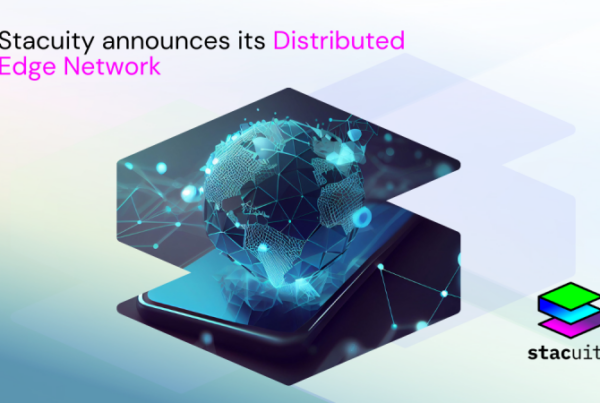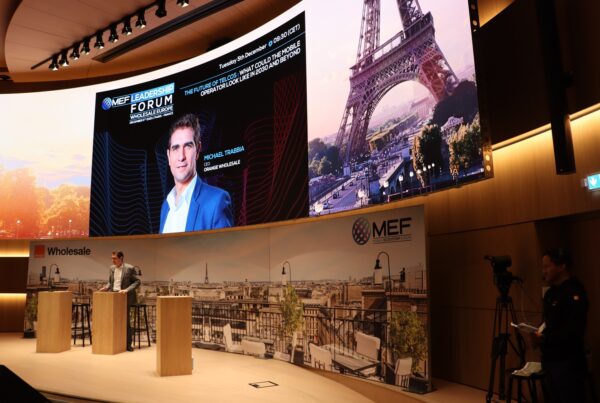At MEF Connects IoT, Andrew Parkin-White is joined by a panel of IoT roaming experts comprising Fernando Llobregat Baena of BICS, Graham Hart-Ives of JT (IoT) Ltd, Dawood Ghalaieny of ZARIOT and Steffen Sorrell of Kaleido Intelligence. The panel tackled issues including the importance of IoT roaming, enterprise needs beyond connectivity, emerging commercial models and the technology choices on offer.
Thinking of the size and scale of the IoT roaming markets, Steffen estimates that there will be a total of 48bn total cellular IoT connections by 2025/6 with around 1bn of those roaming. Important markets include Europe and Australasia due to a favourable regulatory landscape
Watch the MEF IoT Panel in full
Thinking of the size and scale of the IoT roaming markets, Steffen estimates that there will be a total of 48bn total cellular IoT connections by 2025/6 with around 1bn of those roaming. Important markets include Europe and Australasia due to a favourable regulatory landscape. Significant opportunities also exist in America, East Asia and the Pacific. Logistics and automotive are important sectors and as the applications of asset tracking and monitoring. The MEF Global IoT Enterprise Survey revealed that 27% of large enterprises are planning to increase their level of IoT roaming connections.
Emerging markets are concerned about allowing roaming devices onto networks from service and control point of view and Dawood points out that the environment is complex and difficult to navigate with considerable uncertainty over future deployment scenarios . There are different legal frameworks in these markets compared to Europe and US where a roaming device would simply work.
How can roaming suppliers capitalise on opportunities? Steffen points out than tier one MNOs such as AT&T, DT and Vodafone, all play a significant role in roaming and rely on their own footprints for global coverage“
So is the IoT roaming important? Steffen believes so as IoT is a global business. Looking at the automotive sector, supply chains and where vehicles end up is truly global. Manufacturers need a solution for connecting assets and roaming is an integral part. IoT roaming enables data transfer across borders and a partnership ecosystem to be well established with alliances and hubs with connectivity across 700+ operators.
Fernando supports this point and emphasises that IoT roaming is an important part of the value chain where enterprises require instant worldwide coverage and choice over international connectivity with a single point of contact. Graham sees that there are multiple network access opportunities and ubiquity and choice in connectivity is key.
Dawood makes the observation that roaming connectivity is the last piece in the value chain and is the commodity component. Delivering control, management and the ability to select the quality of service are important factors.
Looking at enterprises needs beyond connectivity, Graham sees a broad set of requirements spanning connectivity and autotmatic activation and control built into solution, together with end to end security and network integration. A simple data pipe without control is no longer sufficient. Fernando is of the view that it is not just about the data but able to integrate deeper into production and business processes. Connectivity is one of the earliest requirements in the design and testing phase of a production process.
How can roaming suppliers capitalise on opportunities? Steffen points out than tier one MNOs such as AT&T, DT and Vodafone, all play a significant role in roaming and rely on their own footprints for global coverage. The issue of coverage is ever present. A tier one MNO still has a limited global footprint and faces spiralling costs outside this footprint and a potentially less reliable services. Other players include BICS for roaming hubs and IoT MVNOs who have broad agreements with operators around the world for global connectivity.
Partnerships are valuable in enabling the enterprise to determine how it accesses and controls connectivity. Furthermore, existing commercial roaming models may not be suitable for low power devices with small amounts of data traffic. New models will need an approach that works for both wholesale and retail.
Fernando sees the emergence of these new business models for small amounts of data roaming in several countries. He sees the move to a monthly charge per unit than a traffic charge and points out that this approach is already a reality in roaming deals.
Dawood sees a complex situation stating that monetisation is one aspect but there is a potentially huge cost if IoT devices misbehave on the networks. Malfunctioning devices can cause congestion and downtime and cost the networks money. He believes that the quality of devices is key to mitigate the risk of an IoT device consuming valuable network resources through poor reliability as a result of being low cost. Graham supports the point that devices on the network need to be reliable and that success depends upon the actions of multiple players in the value chain.






